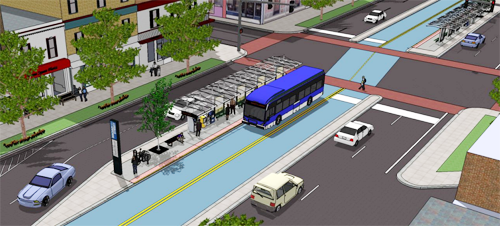
In 2016 the voters approved a referendum to design and build a Bus Rapid Transit (BRT) system spanning 20 miles from downtown Raleigh in four directions. At the time, there was a fair amount of debate about whether we wanted light rail or BRT. In the end, BRT won out because it could be implemented faster, is more flexible with a growing city, and would come at a fraction of the cost.
In November of 2018, the City of Raleigh selected the eastern corridor between downtown and WakeMed Medical Center along New Bern Ave as the first to go through the federal funding process. In order to be considered for federal funding through the Federal Transit Administration (FTA), the City must first complete 30% of the design, prove that they have the funding available to complete the project without federal assistance, and have reasonable public support.
On May 9th the Raleigh Transit Authority (RTA) was informed that city staff plans to hold a 5% design public meeting on June 25, 2019 at Martin Street Baptist Church between 6-8pm. The RTA pointed out the fact that the planned BRT will have a large impact on housing availability and affordability along the route and asked that the planning department be made available at the meeting.
The city wants your feedback on three key BRT components: Running Ways, Cross Sections, and Next Steps.
Running Ways
The Running Ways are how the buses will run along the transit route. Federal funding requires that BRT have at least 50% dedicated lanes to be eligible for reimbursement. The more that’s dedicated, the larger the percentage of reimbursement up to 80% – there are other considerations as well, but this is paramount to federal funding process.
Busways are separated from the travel traffic and provide faster, more reliable service. However, these lanes can sometimes take away travel lanes or medians and often require significant investment in infrastructure.
Bus lanes are in the travel lanes (not separated) but are usually marked bus only and can still be considered dedicated lanes. They are often be impeded by cars turning, vehicles not following the rules of the road, pedestrian crossings, and accidents.
Cross Sections
The Cross Sections are where the dedicated lanes and stations are located on the roadway. In order for the buses to be able to run quickly and avoid traffic issues, the lanes are either separated by a median or by a visual paint on the ground allowing buses to operate independently of congestion. Where those lanes are has a lot to do with the type of road it is.
Median or middle of the road travel provides a fluid flow of the bus and prevents from it being stopped by a car coming out of a driveway or turning right. However it means people need to use the crosswalks to get to the stations and drivers must respect the pedestrians crossing for a bus.
Side lanes provide easier access to the stops for pedestrians, but the bus is continually stopped by turning vehicles and other traffic type of delays.
Next Steps
The comments collected by GoRaleigh will serve to instruct the planners on how they want their transit system to work and implemented into the future planning. The agency is expected to return again when they are at 15% design for another round of public comments on a more pronounced plan for the eastern corridor.
Note: GoRaleigh has already changed the date once, so the date and time may be subject to change. We will update this post and of course follow us on Facebook, Twitter, Instagram, and LinkedIn for further updates.
Wondering how we got here?
WakeUP’s Nathan Spencer contributed to Raleigh4All’s article Bus Rapid Transit for Raleigh




